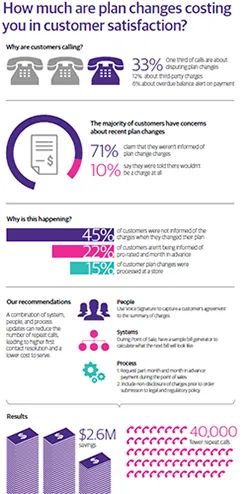Contact centers are primarily designed to operate on efficiency. Because of this, nearly everything about their operations gets measured. But in the fast-paced economy driven by high customer expectations, are companies measuring the right things in the contact center?
Typical metrics found within a contact center are very operational—average handle time, cost per contact, occupancy rate, quality monitoring, schedule adherence, service level, and forecasted calls versus actual calls, just to name a few. These are important operational and performance metrics to manage centers’ costs and workflows, but they do not always capture the customer experience or the success of contact center interactions from the customer’s point of view. As a result, traditional performance metrics alone are becoming outdated.
There is an evolution happening within the contact center. Companies are moving away from simply handling volume efficiently and are beginning to answer the question “why?” Why are people calling? By better understanding why customers are calling, firms can identify and fix root causes of issues, thereby reducing the volume of contact center interactions, rather than just trying to incrementally improve how quickly or cheaply they handle current volume.
As discussed throughout this issue of Customer Strategist, companies of all sorts are clamoring for feedback and insight around the customer experience so they can differentiate by understanding the needs and motivations of customers. Firms are going to great lengths to incorporate social listening, machine learning, and other high-tech approaches to gain actionable insight. Yet too often companies overlook the valuable insight sitting under their noses in their contact centers. By looking at the information differently, more insight may be uncovered.
For example, many contact centers have escalation teams or processes designed to manage issues that can’t be resolved through standard practices. Instead of focusing resources on measuring and managing teams to deal with these types of issues, a company could spend time learning why certain calls might escalate in the first place. Then it could focus attention on how to prevent an issue from ever getting to a point where it needs escalation. Unfortunately, however, few contact centers are set up to operate this way. Too many are judged by how efficiently they conduct operations, leaving no time or resources left to consider tackling “why” questions.

Open the contact center doors to the enterprise
Companies that focus on understanding why their customers are calling versus just handling volume can gain meaningful insights to improve the customer experience across the enterprise. Why did a call come in? Was it a product or service issue? Is something unclear in marketing communications, billing, or product instructions? If a call was escalated or unresolved, why? Was it something relating to the associate, the knowledge base, products or services, customer expectations, or something else?
Where possible, create a real-time feedback loop with the information that’s collected. It’s not enough to find out why people are interacting if the information isn’t shared with decision makers for days, weeks, or months. Create proactive, upstream activities quickly that act on the insight generated. Open the contact center doors to share insights with marketing, finance, IT, product development, and even the c-suite to make necessary changes that improve the customer experience. Change policies, develop different product features, or adjust marketing messages with the confidence that the decisions are being made based on customer insight.
If they’re not already, all contact centers should analyze voice of the customer (VOC), customer satisfaction, and Net Promoter Score (NPS). And make sure that it’s not just operational insight being collected with these analyses. Many customer satisfaction measurements tend to be based on questions related to how quickly or efficiently a person’s call was handled, rather than the actual resolution itself, for example. Look at relationship factors that contribute to insight, as well.
For example, if a contact center sees a simultaneous spike in average handle time (AHT) and negative VOC sentiment, it’s an indication that something is happening to the customer experience that needs attention from the enterprise. Was it a flawed or complicated product launch? Was it a new pricing plan or return policy that was just rolled out? These are enterprise customer experience issues that the contact center can identify and help mitigate with other functions of the business.
Four hows to get to why
Many readers will agree that gaining a deeper understanding of why people interact with the contact center is a good idea. But how can it be done? We recommend four steps to start on the path to learn “why.”
1. Use operational data to drive insights.
Begin looking at your operational metrics not simply as volume or efficiency indicators, but as customer insight indicators. Why is AHT higher on certain days of the week? Why was first call resolution (FCR) lower during new product launches?
2. Automate VOC data gathering.
Strive to gain rich VOC data by using automated speech analytics tools and making that data actionable.
3. Harness social media data.
Include social media monitoring in the contact center. Create a social media dashboard in your contact center that can give you a real-time pulse of customer sentiment.
4. Mash up your data.
Break down your operations, customer experience social media data, and data silos to begin identifying correlation trends. Rich data is available in all places that needs to be looked at cohesively in order to gain the insight and contextual customer picture that can help you get to the “why.”
In their quest to be ever more efficient, many contact center leaders have gotten away from the fact that the real reason for a contact center’s existence is to solve customer problems and help them be better customers of the brand. Empowering customer care by answering “why” will help change the perception of the contact center from a cost center to a value-added part of the business. ?















